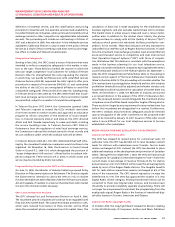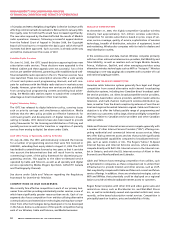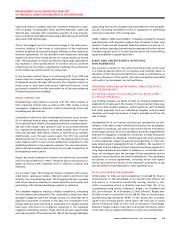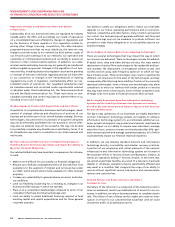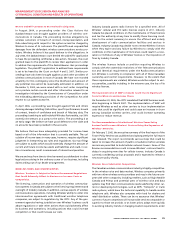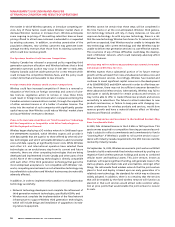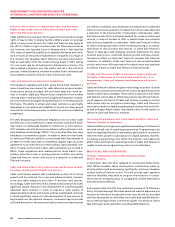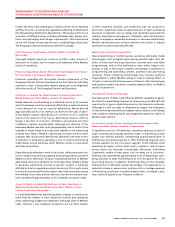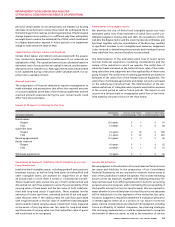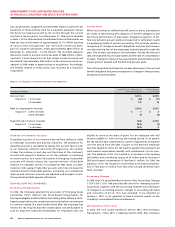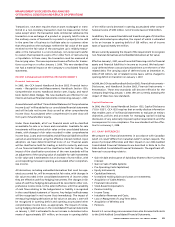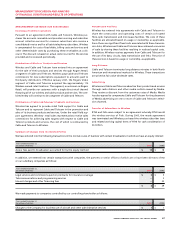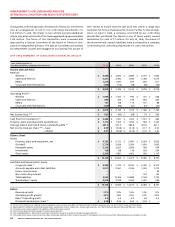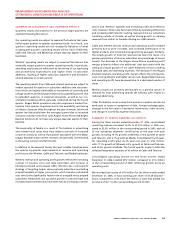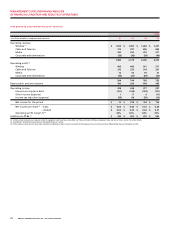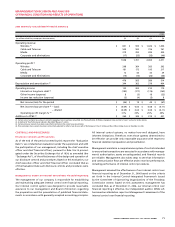Rogers 2006 Annual Report Download - page 65
Download and view the complete annual report
Please find page 65 of the 2006 Rogers annual report below. You can navigate through the pages in the report by either clicking on the pages listed below, or by using the keyword search tool below to find specific information within the annual report.
61
RO GER S CO MMU NIC AT ION S IN C . 20 0 6 ANN UA L RE POR T
MANAGEMENT’S DISCUSSION AND ANALYSIS
OF FINANCIAL CONDITION AND RESULTS OF OPERATIONS
Sales and Marketing Costs (or Cost of Acquisition) per Subscriber
Sales and marketing costs per subscriber, which is also often referred
to in the industry as cost of acquisition per subscriber (“COA”), “sub-
scriber acquisition cost”, or “cost per gross addition”, is calculated by
dividing total sales and marketing expenditures, plus costs related to
equipment provided to new subscribers for the period, by the total
number of gross subscriber activations during the period. Subscriber
activations include postpaid and prepaid voice and data activations
and one-way messaging activations. COA, as it relates to a particular
activation, can vary depending on the level of ARPU and term of a
subscriber’s contract. Refer to “Supplementary Information – Non-
GAAP Calculations” for further details on the calculation.
The wireless communications industry in Canada continues to grow
and the costs of acquiring new subscribers are significant. Because
a substantial portion of subscriber activation costs are variable in
nature, such as commissions paid for each new activation, and due
to fluctuations in the number of activations of new subscribers from
period to period and the seasonal nature of these subscriber addi-
tions, we experience material fluctuations in sales and marketing
expenses and, accordingly, in the overall level of operating expenses.
Operating Expense per Subscriber
Operating expense per subscriber, expressed as a monthly average,
is calculated by dividing total operating, general and administrative
expenses, plus costs related to equipment provided to existing sub-
scribers, by the average number of subscribers during the period.
Operating expense per subscriber is tracked by Wireless as a measure
of our ability to leverage our operating cost structure across a grow-
ing subscriber base, and we believe that it is an important measure
of our ability to achieve the benefits of scale as we increase the size
of our business. Refer to “Supplementary Information – Operating
Expense per Average Subscriber” for further details on this Wireless
calculation.
Operating Profit and O perating Profit Margin
We define operating profit as net income before depreciation and
amortization, interest expense, income taxes and non-operating
items, which include foreign exchange gains (losses), loss on
repayment of long-term debt, change in fair value of derivative instru-
ments, and other income. Operating profit is a standard measure
used in the communications industry to assist in understanding and
comparing operating results and is often referred to by our peers and
competitors as EBITDA (earnings before interest, taxes, depreciation
and amortization) or OIBDA (operating income before deprecia-
tion and amortization). We believe this is an important measure as
it allows us to assess our ongoing businesses without the impact of
depreciation or amortization expenses as well as non-operating fac-
tors. It is intended to indicate our ability to incur or service debt,
invest in PP&E and allows us to compare our Company to our peers
and competitors who may have different capital or organizational
structures. This measure is not a defined term under Canadian GAAP
or U.S. GAAP.
We calculate operating profit margin by dividing operating profit by
total revenue, except in the case of Wireless. For Wireless, operating
profit margin is calculated by dividing operating profit by network
revenue. Network revenue is used in the calculation, instead of total
revenue, because network revenue better reflects Wireless’ core busi-
ness activity of providing wireless services. Refer to “Supplementary
Information – Operating Profit Margin Calculation” for further
details on this Wireless, Cable and Telecom, and Media calculation.
Additions to PP&E
Additions to PP&E include those costs associated with acquiring and
placing our PP&E into service. Because the communications business
requires extensive and continual investment in equipment, including
investment in new technologies and expansion of geographical reach
and capacity, additions to PP&E are significant and management
focuses continually on the planning, funding and management of
these expenditures. We focus more on managing additions to PP&E
than we do on managing depreciation and amortization expense
because additions to PP&E have a direct impact on our cash flow,
whereas depreciation and amortization are non-cash accounting
measures required under Canadian and U.S. GAAP.
The additions to PP&E before related changes to non-cash working
capital represent PP&E that we actually took title to in the period.
Accordingly, for purposes of comparing our PP&E outlays, we believe
that additions to PP&E before related changes to non-cash working
capital best reflect our cost of PP&E in a period, and provide a more
accurate determination for period-to-period comparisons.
CRITICAL ACCOUNTING POLIC IES
This MD&A has been prepared with reference to our 2006 Audited
Consolidated Financial Statements and Notes thereto, which have
been prepared in accordance with Canadian GAAP. The Audit
Committee of our Board reviews our accounting policies, reviews
all quarterly and annual filings, and recommends approval of our
annual financial statements to our Board. For a detailed discussion of
our accounting policies, see Note 2 to the 2006 Audited Consolidated
Financial Statements. In addition, a discussion of new accounting
standards adopted by us and critical accounting estimates are dis-
cussed in the sections “New Accounting Standards” and “Critical
Accounting Estimates”, respectively.
Revenue Recognition
We consider revenues to be earned as services are performed, pro-
vided that ultimate collection is reasonably assured at the time of
performance.
Revenue is categorized into the following types, the majority of
which are recurring in nature on a monthly basis from ongoing rela-
tionships, contractual or otherwise, with our subscribers:
• Monthly subscriber fees in connection with wireless and wireline
services, cable, telephony, Internet services, rental of equipment,
network services, and media subscriptions are recorded as revenue
on a pro rata basis as the service is provided;
• Revenue from airtime, roaming, long-distance and optional
services, pay-per-use services, video rentals, and other sales of
products are recorded as revenue as the services or products are
delivered;
• Revenue from the sale of wireless and cable equipment is recorded
when the equipment is delivered and accepted by the indepen-
dent dealer or subscriber in the case of direct sales. Equipment


